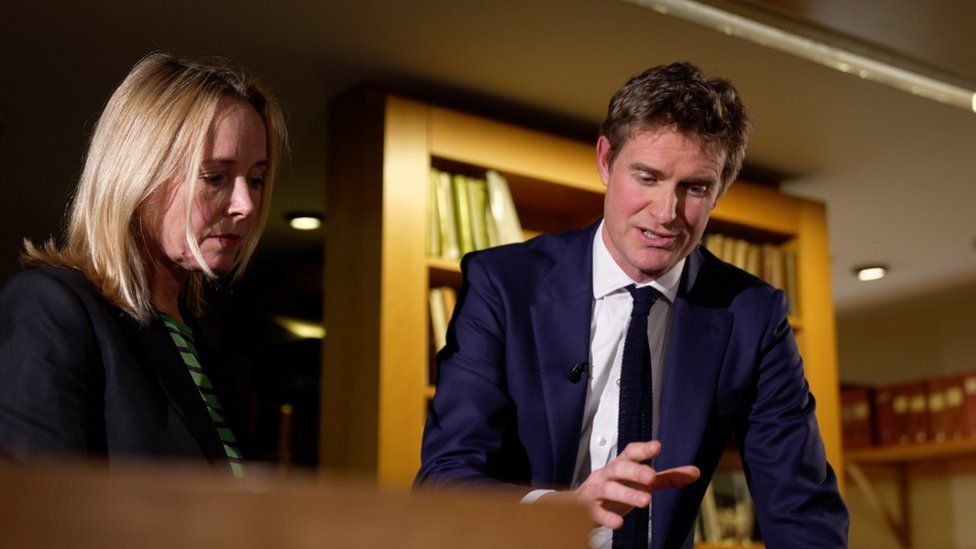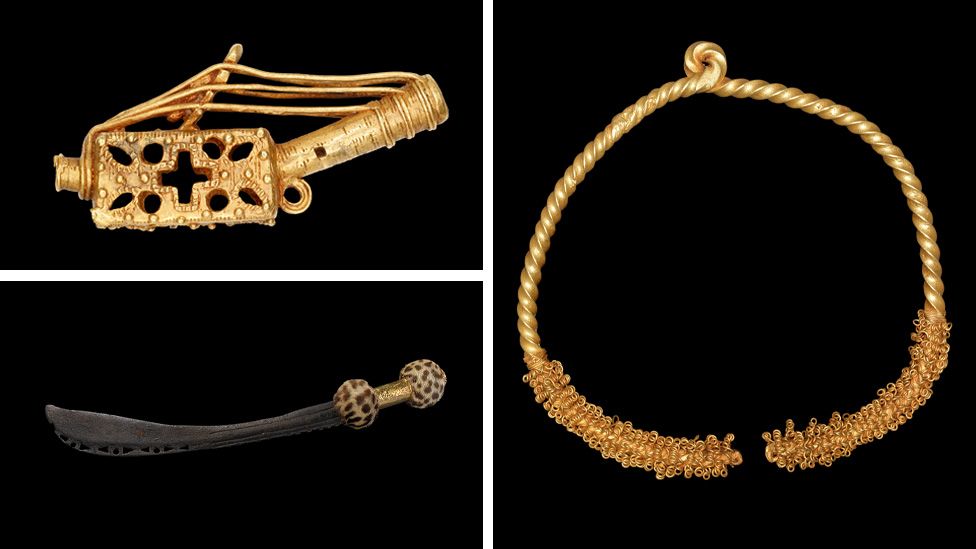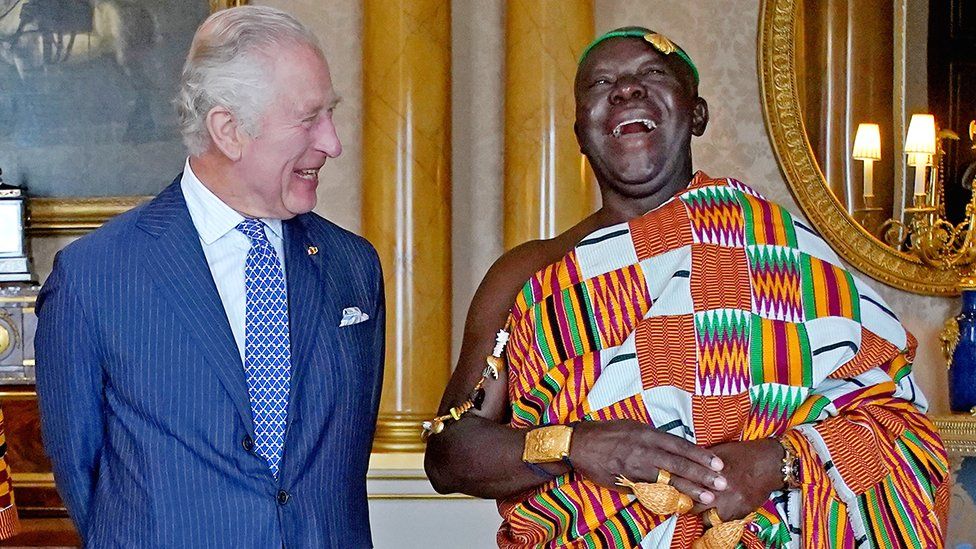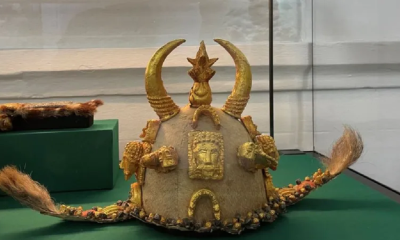Foreign News
Asante Gold: UK to loan back Ghana’s looted ‘crown jewels’

The UK is sending some of Ghana’s “crown jewels” back home, 150 years after looting them from the court of the Asante king.
A gold peace pipe is among 32 items returning under long-term loan deals, the BBC can reveal.
The Victoria & Albert Museum (V&A) is lending 17 pieces and 15 are from the British Museum.
Ghana’s chief negotiator said he hoped for “a new sense of cultural co-operation” after generations of anger.
Some national museums in the UK – including the V&A and the British Museum – are banned by law from permanently giving back contested items in their collections, and loan deals such as this are seen as a way to allow objects to return to their countries of origin. But some countries laying claim to disputed artifacts fear that loans may be used to imply they accept the UK’s ownership.
Tristram Hunt, director of the V&A, told the BBC that the gold items of court regalia are the equivalent of “our Crown Jewels”.
The items to be loaned, most of which were taken during 19th-Century wars between the British and the Asante, include a sword of state and gold badges worn by officials charged with cleansing the soul of the king.

Mr Hunt said when museums hold “objects with origins in war and looting in military campaigns, we have a responsibility to the countries of origin to think about how we can share those more fairly today. “It doesn’t seem to me that all of our museums will fall down if we build up these kind of partnerships and exchanges.”
However, Mr Hunt insisted the new cultural partnership “is not restitution by the back door” – meaning it is not a way to return permanent ownership back to Ghana.
The three-year loan agreements, with an option to extend for a further three years, are not with the Ghanaian government but with Otumfo Osei Tutu II – the current Asante king known as the Asantehene – who attended the Coronation of King Charles last year. The Asantehene still holds an influential ceremonial role, although his kingdom is now part of Ghana’s modern democracy.
The items will go on display at the Manhyia Palace Museum in Kumasi, the capital of the Asante region, to celebrate the Asantehene’s silver jubilee.
The Asante gold artifacts are the ultimate symbol of the Asante royal government and are believed to be invested with the spirits of former Asante kings.

They have an importance to Ghana comparable to the Benin Bronzes – thousands of sculptures and plaques looted by Britain from the palace of the Kingdom of Benin, in modern-day southern Nigeria. Nigeria has been calling for their return for decades.
Nana Oforiatta Ayim, special adviser to Ghana’s culture minister, told the BBC: “They’re not just objects, they have spiritual importance as well. They are part of the soul of the nation. It’s pieces of ourselves returning.” She said the loan was “a good starting point” on the anniversary of the looting and “a sign of some kind of healing and commemoration for the violence that happened”.
UK museums hold many more items taken from Ghana, including a gold trophy head that is among the most famous pieces of Asante regalia.
The Asante built what was once one of the most powerful and formidable states in west Africa, trading in, among others, gold, textiles and enslaved people.
The kingdom was famed for its military might and wealth. Even now, when the Asantehene shakes hands on official occasions, he can be so weighed down with heavy gold bracelets that he sometimes has an aide whose job is to support his arm.
Europeans were attracted to what they later named the Gold Coast by the stories of African wealth and Britain fought repeated battles with the Asante in the 19th Century.
In 1874 after an Asante attack, British troops launched a “punitive expedition”, in the colonial language of the time, ransacking Kumasi and taking many of the palace treasures.

Most of the items the V&A is returning were bought at an auction on 18 April 1874 at Garrards, the London jewellers who maintain the UK’s Crown Jewels.
They include three heavy cast-gold items known as soul washers’ badges (Akrafokonmu), which were worn around the necks of high ranking officials at court who were responsible for cleansing the soul of the king.
Angus Patterson, a senior curator at the V&A, said taking these items in the 19th Century “was not simply about acquiring wealth, although that is a part of it. It’s also about removing the symbols of government or the symbols of authority. It’s a very political act”.
The British Museum is also returning on loan a total of 15 items, some of them looted during a later conflict in 1895-96, including a sword of state known as the Mpomponsuo.

There is also a ceremonial cap, known as a Denkyemke, richly decorated with gold ornaments. It was worn by senior courtiers at coronations and other major festivals.
The British Museum is also lending a cast-gold model lute-harp (Sankuo), which was not looted, to highlight its almost 200-year-old connection with the Asantehenes.
The sankuo was presented to the British writer and diplomat Thomas Bowdich in 1817, who said it was intended as a gift from the Asantehene to the museum to demonstrate the wealth and status of the Asante nation.
Can you loan objects back to a country that says you stole them?
It’s a solution to UK legal restrictions that may not be acceptable to countries which say they want to right a historic wrong.
The issue of the Parthenon Sculptures, or Elgin Marbles as they were named in the UK, is the best-known example.
Greece has long demanded the return of these classical sculptures that are displayed in the British Museum. Its chair of trustees, George Osborne, recently said that he was looking for a “practical, pragmatic and rational way forward” and was exploring a partnership that, in essence, puts the question of who actually owns the classical sculptures to one side.
This agreement with the Asantehene is another version of that; a compromise that works for the Asante king and is possible within the parameters of British law.
Just as Nigeria would be unlikely to accept a loan of the Benin Bronzes, it would have been difficult for Ghana’s government to accept this kind of agreement.
But Mr Hunt said the deals between the V&A, the British Museum and the Manhyia Palace Museum “cut through the politics. It doesn’t solve the problem, but it begins the conversation”.

Ms Oforiatta Ayim, the Ghana culture minister’s adviser, said “of course” people will be angry at the idea of a loan and they hoped to see items eventually returned permanently to Ghana. “We know the objects were stolen in violent circumstances, we know the items belong to the Asante people,” she said.
The British government has a “retain and explain” stance for state-owned institutions, which means contested objects are kept and their context is explained.
Neither the Conservative nor Labour parties have signalled any interest in changing current legislation. The British Museum Act of 1963 and the National Heritage Act of 1983 prevent museum trustees at some high-profile institutions from “deaccessioning” items in their collections.
Mr Hunt is advocating a change in the law. He would like to see “more freedom for museums, but then a kind of backstop, a committee where we would have to appeal if we wanted to restitute items”.
Some have raised concerns this would mean British museums losing some of their most prized items in future. Or as a previous culture secretary, Michelle Donelan, put it to me in relation to a return of the Parthenon Sculptures, that it would “open the gateway to the question of the entire contents of our museums”.
But Mr Hunt said the ownership of very few of the V&A’s collection of 2.8 million items has been disputed.

Another fear is that contested items that go on loan will never be returned.
Ghana’s chief negotiator Ivor Agyeman-Duah scotched that. “You stick to agreements that you have, you don’t go against them,” he said.
There are other beautiful Asante gold items in the UK. The Wallace Collection includes the trophy head which is among the most famous Asante treasures. It too was taken by British forces and bought at the 1874 auction.
The Royal Collection also holds objects including another gold trophy head in the form of a mask. This type of item represented defeated enemies; the trophies were attached by a hoop to ceremonial swords in the state regalia.
Will they ever be on show in Ghana in future? Mr Adyeman-Duah is taking it one step at a time.
But as Britain is increasingly confronting the cultural legacy of its colonial past, these types of agreements may be a diplomatic and practical way to address the past and create better relationships in the future – if both sides can accept the terms.
(BBC)
Foreign News
Nasa ‘Earthrise’ astronaut dies at 90 in plane crash

Apollo 8 astronaut Bill Anders, who snapped one of the most famous photographs taken in outer space, has died at the age of 90.
Officials say a small plane he was flying crashed into the water north of Seattle, Washington.
Anders’ son Greg confirmed that his father was flying the small plane, and that his body was recovered on Friday afternoon. “The family is devastated. He was a great pilot. He will be missed,” a statement from the family reads.
Anders – who was a lunar module pilot on the Apollo 8 mission – took the iconic Earthrise photograph, one of the most memorable and inspirational images of Earth from space.
Taken on Christmas Eve during the 1968 mission, the first crewed space flight to leave Earth and reach the Moon, the picture shows the planet rising above the horizon from the barren lunar surface.
Anders later described it as his most significant contribution to the space programme.

The image is widely credited with motivating the global environmental movement and leading to the creation of Earth Day, an annual event to promote activism and awareness of caring for the planet.
Speaking of the moment, Anders said: “We came all this way to explore the Moon, and the most important thing that we discovered was the Earth.”
Officials said on Friday that Anders crashed his plane around 11:40PDT (1940BST).
The US National Transportation Safety Board (NTSB) said the 90-year-old was flying a Beechcraft A A 45 – also known as a T-34. The agency said that the plane crashed about 80ft (25m) from the coast of Jones Island.
Anders also served as the backup pilot to the Apollo 11 mission, the name of the effort that led to the first Moon landing on July 24, 1969.
Following Anders’ retirement from the space programme in 1969, the former astronaut largely worked in the aerospace industry for several decades. He also served as US Ambassador to Norway for a year in the 1970s.
But he is best remembered for the Apollo 8 mission and the iconic photograph he took from space.
“In 1968, during Apollo 8, Bill Anders offered to humanity among the deepest of gifts an astronaut can give. He traveled to the threshold of the Moon and helped all of us see something else: ourselves,” Nasa Administrator Bill Nelson said in a statement.
Mark Kelly, a former astronaut who now serves as a US Senator for the state of Arizona, said in a post on X, formerly Twitter, that Anders “inspired me and generations of astronauts and explorers. My thoughts are with his family and friends”.
[BBC]
Foreign News
China’s Chang’e-6 lifts off from far side of Moon with rock samples

A Chinese spacecraft carrying rock and soil samples from the far side of the Moon has lifted off from the lunar surface to start its journey back to Earth, according to state media.
The achievement on Tuesday is a world first and the latest leap for Beijing’s decades-old space programme, which aims to send a crewed mission to the Moon by 2030.
The Xinhua News Agency, citing the China National Space Administration (CNSA), said that the ascender of the Chang’e-6 probe took off at 7:38am local time on Tuesday (23:38 GMT) and entered a preset orbit around the moon.
It described the move as “an unprecedented feat in human lunar exploration history”.
The Chang’e-6 probe was launched last month and its lander touched down on the far side of the Moon on Sunday. It used a drill and robotic arm to dig up soil on and below the Moon’s surface, according to Xinhua.
After successfully gathering its samples, the Chang’e-6 unfurled China’s national flag for the first time on the far side of the Moon, it said.
The agency cited the CNSA as saying that the spacecraft stowed the samples it had gathered in a container inside the ascender of the probe as planned.
[Aljazeera]
Foreign News
China says its spacecraft lands on Moon’s far side

China says its uncrewed craft has successfully landed on the far side of the Moon – an unexplored place almost no-one tries to go.
The Chang’e 6 touched down in the South Pole-Aitken Basin at 06:23 Beijing time on Sunday morning (22:23 GMT Saturday), the China National Space Administration (CNSA) said.
Launched on 3 May, the mission aims to collect precious rock and soil from this region for the first time in history. The probe could extract some of the Moon’s oldest rocks from a huge crater on its South Pole.
The landing was fraught with risks, because it is very difficult to communicate with spacecraft once they reach the far side of the Moon. China is the only country to have achieved the feat before, landing its Chang’e-4 in 2019.
After launching from Wenchang Space Launch Center, the Chang’e 6 spacecraft had been orbiting the Moon waiting to land. The lander component of the mission then separated from the orbiter to touch down on the side of the Moon that faces permanently away from Earth.
During the descent, an autonomous visual obstacle avoidance system was used to automatically detect obstacles, with a visible light camera selecting a comparatively safe landing area based on the brightness and darkness of the lunar surface, the CNSA was quoted as saying by state-run Xinhua news agency.
The lander hovered about 100m (328ft) above the safe landing area, and used a laser 3D scanner before a slow vertical descent. The operation was supported by the Queqiao-2 relay satellite, the CNSA said.
Chinese state media described the successful landing as an “historic moment”. The state broadcaster said “applause erupted at the Beijing Aerospace Flight Control Center” when the Chang’e landing craft touched down on the Moon early on Sunday morning.
The lander should spend up to three days gathering materials from the surface in an operation the CNSA said would involve “many engineering innovations, high risks and great difficulty”. “Everyone is very excited that we might get a look at these rocks no-one has ever seen before,” explains Professor John Pernet-Fisher, who specialises in lunar geology at the University of Manchester.
He has analysed other lunar rock brought back on the American Apollo mission and previous Chinese missions. But he says the chance to analyse rock from a completely different area of the Moon could answer fundamental questions about how planets form.
Most of the rocks collected so far are volcanic, similar to what we might find in Iceland or Hawaii. But the material on the far side would have a different chemistry . “It would help us answer those really big questions, like how are planets formed, why do crusts form, what is the origin of water in the solar system?” the professor says.
The mission aims to collect about 2kg (4.4lb) of material using a drill and mechanical arm, according to the CNSA.
The South Pole–Aitken basin, an impact crater, is one of the largest known in the solar system.
From there, the probe could gather material that came from deep inside the lunar mantle – the inner core of the Moon – Prof Pernet-Fisher says.
The Moon’s South Pole is the next frontier in lunar missions – countries are keen to understand the region because there is a good chance it has ice.

The capsule in the last Chinese moon mission, Chang’e 5, brought back soil and rocks in 2020 (BBC)
Access to water would significantly boost the chances of successfully establishing a human base on the Moon for scientific research.
If the mission succeeds, the craft will return to Earth with the precious samples on board a special return capsule.
The material will be kept in special conditions to try to keep it as pristine as possible.
Scientists in China will be given the first chance to analyse the rocks, and later researchers around the world will be able to apply for the opportunity too.
This is the second time China has launched a mission to collect samples from the Moon.
In 2020 Chang’e 5 brought back 1.7kg of material from an area called Oceanus Procellarum on the Moon’s near side.
China is planning three more uncrewed missions this decade as it looks for water on the Moon and investigates setting up a permanent base there.
Beijing’s broader strategy aims to see a Chinese astronaut walk on the moon by around 2030.
The US also aims to put astronauts back on the moon, with Nasa aiming to launch its Artemis 3 mission in 2026.
(BBC)
















